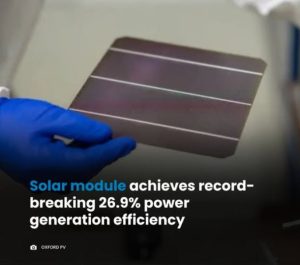
Solar module achieves record-breaking 26.9% power generation efficiency
The 17 sq ft double-glass module, utilizing perovskite-on-silicon tandem solar technology, weighs less than 55 pounds.
Oxford PV leads the way in commercializing next-generation cells with the ‘miracle material’ perovskite.
Ahighly efficient solar module that converts sunlight to electricity has been developed by a German clean energy startup.
Created by a University of Oxford research spin-off called Oxford PV, its residential-size solar panel recorded an efficiency figure of 26.9 percent.
The team’s panel enhances the efficiency of traditional silicon-based solar panels by incorporating an innovative ‘miracle material’ called perovskite, which is a calcium titanium oxide mineral composed of calcium titanate.
With a defined area of a little over 17 square feet, the innovative double-glass module weighs less than 55 pounds (25 kilograms) and is the perfect size for household applications.
According to the firm, the new technology will allow “homeowners along with commercial and utility customers to benefit from upwards of 20 percent more power with the same footprint,” said David Ward, CEO of Oxford PV, in a statement.
Next-gen solar tech
The practical and financial efficiency limit of silicon, the predominant solar photovoltaic technology, is reaching saturation. The team aims to break the barrier to solar efficiency using its perovskite solar cell technology.
Oxford PV claims that enhancing silicon photovoltaics’ performance significantly will allow for cost savings that will change the economics and quicken solar energy’s global expansion.
When integrated with conventional silicon solar cells, perovskite forms tandem cells that surpass traditional silicon photovoltaics’ performance limits.
The combination of perovskite and silicon results in a theoretical efficiency limit of 43 percent, significantly higher than the 29 percent limit for standalone silicon cells.
According to the firm, perovskite materials offer a wide adjustable bandgap, enabling them to capture and convert specific segments of the solar spectrum, particularly the high-energy blue end, into electricity.
Moreover, perovskite photovoltaics present a low-cost, thin-film solution utilizing widely available and inexpensive source materials. Their production involves simple manufacturing processes, making them an economically viable option for large-scale solar energy deployment.
Oxford PV claims that the incorporation of perovskite materials into solar technology enhances overall efficiency and promises a sustainable and cost-effective future for the photovoltaic industry.
“For the past decade, the team has continued to demonstrate the potential for perovskite on silicon tandem solar cells, setting and breaking efficiency records along the way. Now, we are taking the next steps to bring this high-efficiency solar technology into commercial use to support our vision of an all-electric future,” said Chris Case, CTO at Oxford PV.
Boosting solar efficiency
Oxford PV’s production process involves integrating perovskite-on-silicon solar cells with conventional silicon solar cells. The team claims that new cells achieve at least 20 percent greater efficiency.
This improvement allows silicon solar cells to deliver enhanced performance on the same footprint, driving cost reductions that transform the economics of silicon-based solar energy.
According to the firm, traditional 166 mm x 166 mm silicon bottom cells typically achieve 20-22 percent efficiency, but with its perovskite top cells, the resulting tandem solar cells can exceed 30 percent efficiency.
This tandem solution not only breaks through silicon’s efficiency limits, allowing more power generation per unit area, but is also designed for seamless integration into standard PV solar modules.
The company claims its technology enables manufacturers to offer a higher-performance, differentiated product. “Not only does this save installation costs, it also speeds up the decarbonization journey and can contribute to the global energy transition in a meaningful way,” said Ward.
The company intends to increase production of its next-generation solar cells at its factory, which it has already established in Brandenburg a der Havel, Germany.


